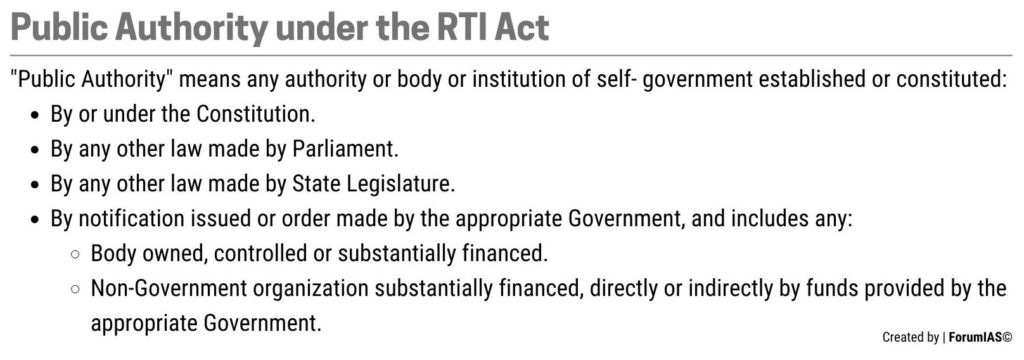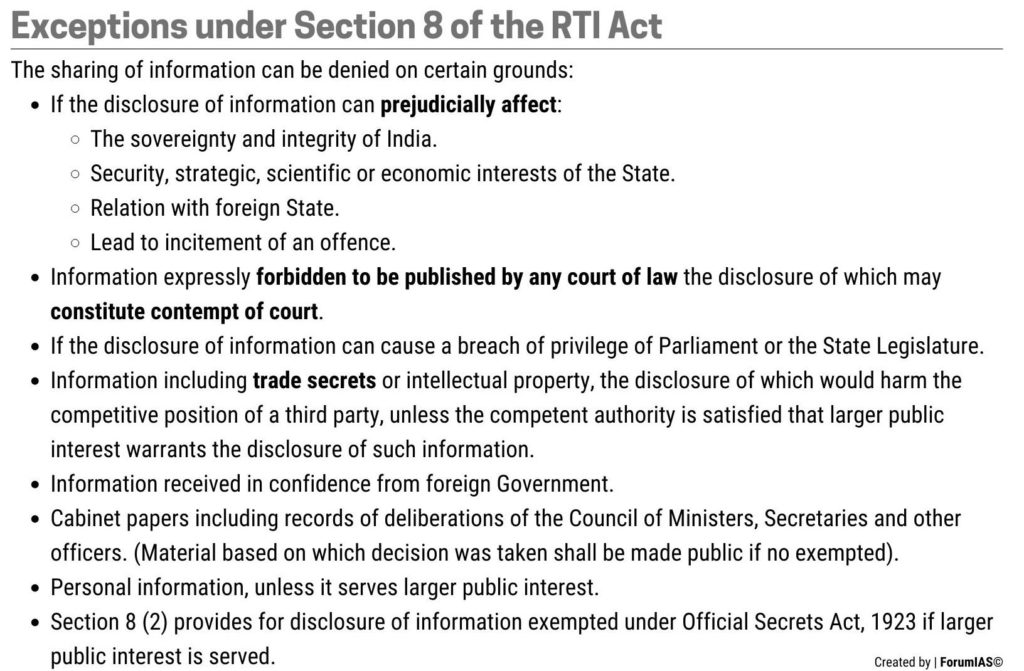ForumIAS announcing GS Foundation Program for UPSC CSE 2025-26 from 19 April. Click Here for more information.
Contents
- 1 Introduction
- 2 What are the salient provisions of the RTI Act, 2005?
- 3 What is the significance of the RTI Act?
- 4 How has the RTI Act performed in recent times?
- 5 What are the issues associated with the functioning of the RTI Act?
- 6 What steps can be taken to enhance the efficacy of the RTI Act?
- 7 Conclusion
| For 7PM Editorial Archives click HERE → |
Introduction
According to Thomas Jefferson “Information is the currency of democracy” and critical to the emergence and development of a vibrant civil society. Democracy requires an informed citizenry and transparency of information which are vital to its functioning and also to contain corruption and to hold the government accountable. Considering this, the Right to Information (RTI) Act was passed by Parliament in 2005 to enable the citizens to exercise their freedom of speech and expression under Article 19(1)(a) of Indian Constitution. There are many success stories associated with the RTI Act. However, certain pressing concerns associated with the functioning of the Act still remain which require urgent redressal.
What are the salient provisions of the RTI Act, 2005?
The RTI Act provides for timely disclosure of information to citizens by Union and State Public Authorities. It seeks to empower citizens and promote accountability and transparency. Under the Act, Public Authorities are required to make disclosures on various aspects of their structure and functioning. This includes; (a) Disclosure on their organization; (b) Functions and structure; (c) Powers and duties of its officers and employees; (d) Financial information; (e) Procedure followed in the decision making process, including channels of supervision and accountability etc. among others.
Section 4 of the Act calls for proactive disclosure of information by all authorities so that the public have minimum resort to the use of this Act to obtain information.
Section 8 of the Act provides exceptions to the disclosure of information, basis which sharing of information can be denied.
Under the Act, the public authorities have to designated some of its officers as Public Information Officer (PIO). They are responsible to give information to a person who seeks information under the RTI Act. The Act has established the Central Information Commission at the level of Central Government and State Information Commission in each State. The Commissions address public grievances against public authorities in case of non-fulfilment of obligations under the Act.
Under the Act, information is very broadly defined. A citizen can request a range of different types of information in a range of different formats including: (a) Obtaining certified copies of documents or records; (b) Inspecting records; (c) Inspecting public works and taking samples of material from public works etc.
The Act requires that PIOs shall provide information within 30 days but applications requesting information regarding a citizen’s life and liberty must be granted or refused within 48 hours. An appeal can be made to a departmental Appellate Authority, who is an officer senior in rank to the PIO but in the same public authority. The Appellate authority has to hear both the parties before giving a decision on the correctness of the order passed by the PIO. A second appeal can also be made to the Information Commission if the decision of the Appellate Authority is not satisfactory.
What is the significance of the RTI Act?
Anti-corruption tool: In the past 17 years, it has been instrumental in uncovering a list of major scams. Scams like Adarsh Society Scam, 2G scam, Commonwealth Games Scam, Indian Red Cross Society Scam are some noticeable achievements under RTI. The success of the Act earned it the 4th place among 111 countries in the annual rating of similar empowering laws across the world in the year 2016.
Empowered people’s voice: It has given ordinary citizens the confidence and the right to ask questions of Government authorities. The RTI Act has empowered people in containing corruption and bringing transparency and accountability in the working of the Government.
Strengthened Democracy: Every citizen has the right to claim information from public authorities under the Act. On the other hand, public authorities have an obligation to provide the sought information to the applicants (with certain exceptions). This has strengthened democracy through active participation of the public.
Transparency and Accountability: A large amount of information has to be placed in the public domain by ways of manuals prescribed under the Act. All the Government departments along with a number of bodies which receive substantial funding from the Government have been brought under the RTI. This has ushered in an era of transparency and accountability.
How has the RTI Act performed in recent times?
According to an estimate, between 40 and 60 lakh RTI applications are filed every year, but less than 3% Indian citizens have ever filed an RTI plea.
A ‘Report Card of Information Commissions in India, 2018-19’ was released by the Satark Nagrik Sangathan (SSN) and the Centre for Equity Studies (CES). It revealed that, of the applications filed, less than 45% received the information they had sought. Further, of the 55% who didn’t receive the information, less than 10% filed appeals.
As per a study by the Commonwealth Human Rights Initiative, between 2012-13 and 2018-19, the number of RTI pleas with various Union Government offices rose by 83% — from 8.86 lakh to 16.30 lakh. However, the number of CPIOs mandated to handle them increased by only about 13% — from 21,204 to 24,048. More importantly, there was a sharp fall in the mandatory reporting of data by Ministries and Departments to the CIC.
As on June 30, 2021, 2.56 lakh appeals were pending with 26 Information Commissions in the country. It takes 6 years and 8 months to dispose of a matter in Odisha, as per the going rate, according to the Satark Nagrik Sangathan (SNS) 2021 report.
What are the issues associated with the functioning of the RTI Act?
Threats to RTI Activists: According to the Commonwealth Human Rights Initiative (CHRI), across India, 99 RTI activists have lost their lives, 180 assaulted and 187 were threatened since 2006. While RTI is lauded in public, it faces fierce opposition from many within the bureaucracy and the lawmakers, the two key stakeholders of the RTI regime. The latest incident happened in June 2022, when a contractor was murdered in Vidisha, Madhya Pradesh, for asking too many questions relating to the public works department. According to the local police, too many RTI queries over the quality of roads were upsetting several officials and interested parties.
| Read More: Whistleblower Protection in India – Explained, pointwise |
Shortcomings of CICs and SICs: Barring some notable exceptions, the State Information Commissions have remained dysfunctional. There are lot of vacancies and many Commissions are functioning without the Chiefs e.g., the Government of Andhra Pradesh took over a year to appoint three information commissioners, that too after the intervention of the Supreme Court, while the post of State Chief Information Commissioner had been vacant for over 2 years.
Moreover, the Commissions have become a place for adjusting retired government officials. According to the 2018-19 SSN-CES ‘Report Card’, of the 374 information commissioners appointed in the SICs since 2005, over 58% were former government officials. Of the 115 chief information commissioners appointed during this period, over 83% were retired government servants, with 64% cent from the IAS.
According to a former CIC (and bureaucrat), the functioning of the Commissions have been stifled by poor choice of commissioners, untrained staff and a non-cooperative set of public information officers (PIOs).
Rising Pendency: The pendency of cases under the Central Information Commission has been rising. The CIC takes up two kinds of cases; (a) Appeals on the information shared under the RTI Act by various government entities; (b) Complaints relating to the inability to file an RTI or refusal to give information. In October 2017, the CIC had 24,287 appeals and complaints pending before it. In October 2020, this figure had increased by 52% to 36,894. Though the number came down to 32,000 in December 2021 and 26,500 in July 2022.
Judicial Bottlenecks: Several RTI cases are embroiled in judicial procedures as courts are quick to give stay orders on CICs’ decisions. However, the Act clearly states that the final appeal lies with the information commissions, so the appeals are masked as writs to obtain relief from the Judiciary.
Frivolous RTIs: An oft-repeated excuse by bureaucrats for their unprofessional attitude is the number of frivolous queries or those with perverse motives. The reality, however, is that such queries constitute only around 4% of the total appeals and can easily be managed.
Downgrading status of Information Commissioners: The salaries, allowances and other terms of service of information commissioners are now decided by the Union Government while earlier these were at par with election commissioners. Many experts believe this has hindered independence of information commissioners. In 2019, the Union Government reduced the fixed tenure from 5 years to 3 years.
Low awareness level: Awareness about RTI is still very low. Awareness level is low, especially among the disadvantaged communities such as women rural population, OBC/SC/ST population.
What steps can be taken to enhance the efficacy of the RTI Act?
First, a code of conduct must be evolved for the Central and State Information Commissioners. It is imperative for the commissioners to keep a strict distance from government heads and officialdom.
Second, the Supreme Court’s guidelines in DDA vs Skipper Construction (P) Ltd should be followed in letter and spirit. It said; (a) High Courts must resist the temptation to exercise their writ jurisdiction in order to correct errors made by the SICs/CICs; (b) If the High Court quashes a CIC/SIC order, it must categorically find that the order was without jurisdiction or palpably erroneous.
Third, the Indian information law, rated as one of the strongest in the world, needs to be bolstered by raising awareness amongst the people and organizing rigorous training of government officials.
Fourth, It is imperative to ensure freedom of the press and democratic institutions, punish errant officials and maintain complete autonomy of the information commissions, in the interest of the people and the nation at large.
Fifth, all information associated with the RTI Act and its functioning must be made available in the local language considering the diverse nature of our country.
Sixth, education about the right to information/ right to know should be made mandatory at the school level in our new education policy to develop a sense of responsibility and vigilant citizenship in the forthcoming generation.
Conclusion
Since the implementation of the RTI Act, it has established itself as an important tool in handling corruption and inefficiency in the Government. Although there have been instances of misuse of the Act, nonetheless it has served its purpose well. The need of the hour is to remove the loopholes in RTI to further the objectives of transparency and accountability.
Syllabus: GS II, Important aspects of governance, transparency and accountability.
Source: Indian Express, Vikaspedia, The Print, Mint






